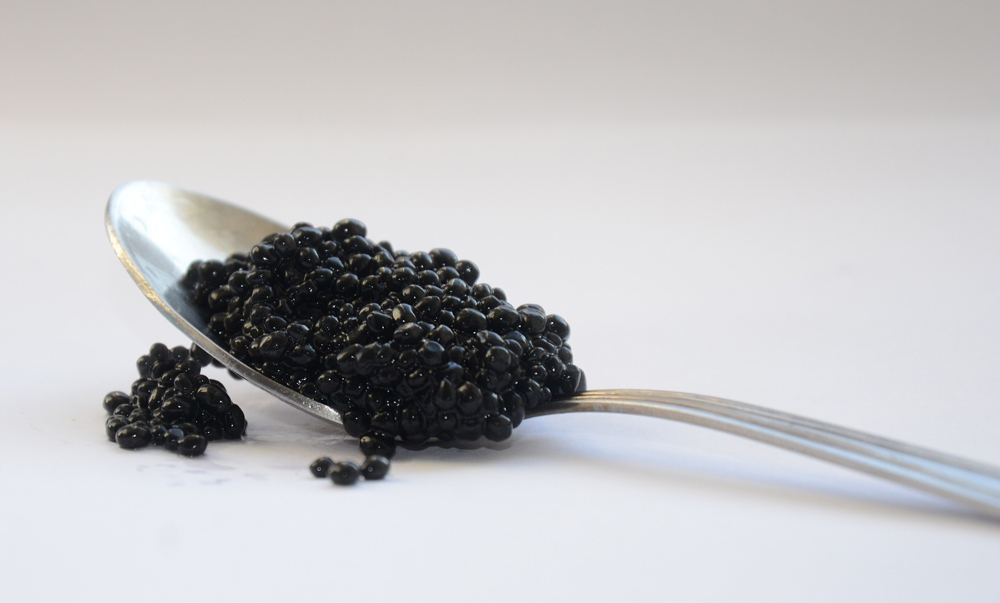Caviar is having a big moment right now, and here's why
Feb 13, 2018

In 1967, satirist André Launay penned Posh Food, a tongue-in-cheek treatise into the world of the elite. In it he decreed: “If you must give yourself the illusion that you are impressing everyone by serving caviar, then you must do so in the grand style by providing your guests with half a dozen tins of the stuff into which they can dip freely, even if they are a little bit sick afterwards.’’ There, in that one scathing sentence, lies all that is both good and bad about caviar.
Caviar is like wine in that it’s delicious, pretentious and generally intimidating. Surrounded by centuries of history, customs and prestige, these highly prized sturgeon eggs are shrouded in mystery for most. Before Russia and Iran cornered the market, caviar was beloved by ancient Romans, Greeks and Chinese, who lauded its medicinal and aphrodisiacal benefits; it graced the tables of czars in abundance, while in medieval England, King Edward II decreed the sturgeon a royal fish – a protection it still enjoys.

Caviar’s popularity, however, became its undoing. When the Soviet Union collapsed, so too did any semblance of fishing regulation in the surrounding waters. Sturgeon poachers flocked to the unguarded seas and soon, the population of the huge-snouted fish was dangerously depleted. It has been estimated that stocks of the beluga, the largest and most sought-after of the sturgeon family, plummeted by 90 per cent in just 20 years, causing the United States to ban wild imports in 2005. The price of the coveted roe skyrocketed – and a devastating black market emerged.
But that’s all changing now, thanks to sturgeon farms. These fisheries, scoffed at as recently as the 1990s, are now flourishing. They’ve spent the past decades perfecting their trade; today, the quality of farmed caviar rivals that of the wild-caught options. These high-value farms exist around the world, particularly in the United States and across Europe, where the late Pierre Bergé (of Yves Saint Laurent fame) once owned a fishery. They even exist in Asia – and China, unsurprisingly, dominates the nascent market. Chinese caviar can be found in most of Hong Kong’s top restaurants and hotels, including the Four Seasons and the Mandarin Oriental.

The rise of these much more sustainable farmed options has led to a drop in caviar prices; as a result, the proletariat are having a big caviar moment. In the United States, this once ultra-luxurious and exclusive product is being slathered on, over and in dishes with a brand new kind of decadence – a greasy one. David Chang’s Momofuku serves it by the 113-gram tin alongside fried chicken, while famed cocktail bar PDT serves 50 grams of Russ & Daughters paddlefish caviar atop crispy fried tater tots. Caviar options are becoming so plentiful that the internet is imploring home cooks to scoop a generous dollop atop their morning toast or even on their favourite crisps.

In Hong Kong, we’re still a few years away from fried chicken and caviar, but the change is coming, if ever so slowly. At the Four Seasons, executive chef Andrea Accordi straddles the divide between past and future. “I believe caviar has a refined taste that is best appreciated with delicate ingredients,” he says when asked about the American trend. In Hong Kong, it typically appears as a garnish – what Accordi calls a “complementary part of a complete dish”, often with sea urchin or beef. For him, the city still views caviar as a luxury item, but his guests are more than happy to adventure beyond blini and mother-of-pearl spoons when offered the chance. “Peking duck and caviar is another popular combination,” he says. “We offered this last year during a caviar promotion in The Lounge and we sold out of it almost every night.” When indulging himself, Accordi opts for a generous spoonful, a habit he picked up during his time working in Saint Petersburg.
Down the road at the Mandarin Oriental, that bastion of old-world refinement, executive chef Robin Zavou has noticed the change in consumer tastes – and he’s keeping up. “We’re looking to use it with pumpkin at the moment and will continue to explore other ways to incorporate this ingredient,” he says. Like most chefs, Zavou keeps an eye on the market, taking great care to source from the best suppliers. He’s even tried the revolutionary no-kill caviar, a process nine years in the making, but didn’t notice much of a difference in the final result. For him, it’s all about the quality of the ingredients and the comfort of the consumer. “As long as the flavours work, anyone should be able to have caviar however they see fit,” he professes. Zavou’s own tastes, however, veer towards the traditional – he prefers caviar served with warm toast or blini.

It seems then, that Hong Kong’s caviar revolution is looming, however slowly. But if you want to spread caviar across a ham-and-cheese baguette, do it – with all your heart. Forget your manners or your unwarranted fears of social station. Scoop wildly and without abandon into countless tins of (sustainable) caviar, and live your czariest life.
This feature originally appeared in the January 2018 print issue of #legend




























